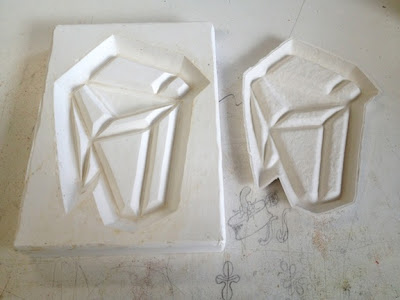As you can see from the photograph, there are a lot of projects underway in the studio, which is great. It's like a cozy cave of self indulgence. But for the uninitiated visiter it's visual chaos, bordering on a hoarder's hovel.
This week I have a studio visits lined up with Heyd Fontenot from CentralTrak. I personally reached out to him, asking if he would come by my studio to look at a few art projects. The focus of this visit will be on the World Of Nomadic Fungi, a joint project I'm doing with the Nomadic Fungi Institute.
This week I have a studio visits lined up with Heyd Fontenot from CentralTrak. I personally reached out to him, asking if he would come by my studio to look at a few art projects. The focus of this visit will be on the World Of Nomadic Fungi, a joint project I'm doing with the Nomadic Fungi Institute.
Inviting someone to visit your studio is not to be taken lightly. You are asking them to go out of their way and spend their time indulging your need to have someone look at your artwork. You also have to keep in mind that your time with them is limited, somewhere between 1 and no longer than 2 hours. So, part of presenting yourself as a professional artist means having the artwork and the topics of discussion organized.
As a lot of you know, I spent last year cruising around on the Queasy Tugboat. This visit with Heyd is the first conversation I have had about my artwork with a respected art professional in quite sometime. I'll admit I'm having some anxiety and loosing a little sleep. To combat the jitters I made the following To Do List for myself:
1. Select/edit the artwork I want to focus on. Arrange it so that the visitor can see it without too much competing visual clutter. It should be mainly finished work, but a few works in progress mixed in is a good thing. The finished work is after all my product, what I will be showing to the public. And the works in progress show that I have new and exciting things coming up soon.
2. Decide what are the important topics I want to discuss. I am well aware that once I get started talking I can ramble on and on about art, art concepts, artists and the art world in general, and never get around to talking about MY artwork. So make a list that I can refer back to if/when we get too far off topic.
3. Next, I invited this person because they have skills and talents that are relative to what I am doing in the studio. So, create another list, this one focusing on their special skills and experiences. Make sure to incorporate this list into relative questions; You have experience working with alternative exhibit spaces, How do you approach people/businesses about setting up an exhibit in their space?
4. Talking is dry work, and listing sometimes requires a cool beverage to make things easier to swallow. Think about a gallery opening without wine and cheese. People simply don't linger when their hands are empty. Make sure there are beverages to offer; wine, beer, lemonade, sparkling water.
5. Lastly, burn a CD with an up to date CV and good images of my artwork. Don't forget to give it to him before he leaves!
Well, looks like I have everything covered. I should sleep like a baby tonight.... Wait a minute, I haven't even started cleaning up the studio!















